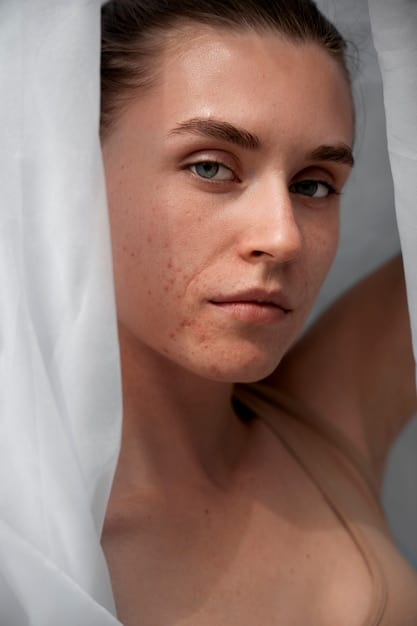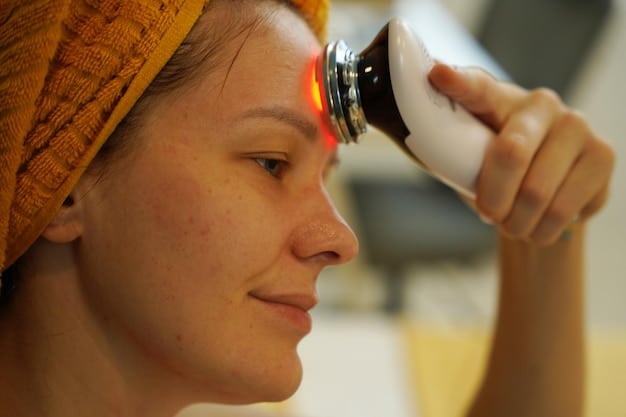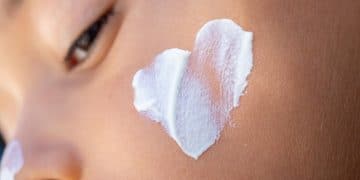How to Get Rid of Acne Scars: A Comprehensive Guide

Anúncios
Navigating the complexities of post-acne skin requires a multifaceted approach, from understanding scar types to exploring advanced dermatological treatments and consistent at-home care, all focused on promoting skin healing and regeneration for clearer complexions.
Acne can be a challenging skin condition, but its aftermath, in the form of scars, often presents a more persistent battle for many. Understanding how to get rid of acne scars: a comprehensive guide is crucial for anyone seeking to restore clear, even-toned skin and regain confidence. This journey requires patience, knowledge, and a tailored approach to effectively address the diverse types of scars that can arise.
Understanding Acne Scars and Their Formation
Acne scars are more than just temporary blemishes; they are the lasting marks of inflammation and tissue damage that occur deep within the skin. When acne lesions, such as cysts, nodules, or even severe papules, become inflamed, they can cause significant disruption to the collagen and elastic fibers that give skin its smooth, even texture. The body’s natural healing response, while often effective, can sometimes lead to either an overproduction or underproduction of tissue, resulting in different types of scars.
The severity and type of acne play a significant role in scar formation. More inflammatory and deeper lesions are inherently more likely to leave behind permanent marks. Genetics also contribute, as some individuals are predisposed to scarring more readily than others, even from less severe breakouts. Furthermore, picking or squeezing pimples can exacerbate inflammation and impede the natural healing process, significantly increasing the likelihood and severity of post-inflammatory marks.
The Main Types of Acne Scars
Understanding the specific type of scar is paramount for effective treatment, as each demands a distinct approach. These classifications guide dermatologists and individuals toward the most appropriate interventions for optimal outcomes.
- Atrophic Scars: These are the most common type, characterized by depressions in the skin. They result from a loss of tissue during the healing process.
- Ice Pick Scars: Small, narrow, deep scars that resemble a puncture mark. They can be particularly challenging to treat due to their depth, extending into the dermis.
- Boxcar Scars: Wider than ice pick scars with sharply defined edges but not as deep. They give the skin a pitted appearance and are common on the cheeks and temples.
- Rolling Scars: Characterized by a wavelike or rolling appearance due to fibrous bands of tissue developing underneath the skin, pulling the epidermis down. These are often broad and shallow.
- Hypertrophic and Keloid Scars: Less common with acne, these are raised scars that result from an overproduction of collagen during healing. Hypertrophic scars remain confined to the original wound area, while keloids extend beyond it.
Distinguishing between these scar types is the first critical step in any treatment plan. A proper diagnosis, often made by a dermatologist, ensures that the selected remedies are targeted and effective, avoiding ineffective or potentially harmful approaches for a given scar type. The journey to smoother skin begins with this fundamental understanding.
At-Home Remedies and Over-the-Counter Options
For individuals with mild acne scarring, particularly those dealing with post-inflammatory hyperpigmentation (PIH) or very superficial atrophic marks, a variety of at-home remedies and over-the-counter (OTC) products can offer noticeable improvement. These methods primarily work by promoting mild exfoliation, evening out skin tone, and stimulating cellular turnover.
Consistency is paramount when using at-home treatments. Results are rarely immediate and often require diligent application over several weeks or even months to become apparent. Patience and adherence to a routine are key to maximizing the benefits of these less invasive approaches. It’s also important to manage expectations; while these remedies can significantly improve skin appearance, they may not entirely eliminate deeper or more severe scars.
Topical Treatments and Ingredients
Many OTC products contain active ingredients known for their skin-renewing and brightening properties. Incorporating these into a daily skincare regimen can help fade discoloration and improve skin texture over time.
- Retinoids (Retinol): Derivatives of Vitamin A, retinoids accelerate cell turnover, helping to shed damaged skin cells and promote the growth of new, healthier ones. This can smooth texture and reduce the appearance of superficial scars.
- Alpha Hydroxy Acids (AHAs – Glycolic Acid, Lactic Acid): These chemical exfoliants gently remove the outer layer of dead skin cells, revealing fresher skin underneath. Regular use can improve skin texture and reduce the visibility of shallow scars.
- Salicylic Acid: A beta hydroxy acid (BHA) that penetrates oil and exfoliates within the pores. While primarily known for acne treatment, its exfoliating properties can also aid in improving overall skin texture and mild scarring.
- Vitamin C (Ascorbic Acid): A powerful antioxidant that brightens the skin, fades hyperpigmentation, and supports collagen production. It can help reduce the appearance of red or brown marks left by acne.
- Niacinamide (Vitamin B3): Reduces inflammation, minimizes pore appearance, and improves skin barrier function. It can also help reduce redness and hyperpigmentation associated with post-inflammatory changes.
- Sunscreen: Crucial for preventing existing scars from darkening. UV exposure can worsen hyperpigmentation, making scars more prominent. Daily, broad-spectrum SPF 30+ is essential.
When starting new topical treatments, it’s advisable to introduce them gradually to avoid irritation, especially with retinoids and AHAs. A patch test on a small area of skin before full application can help identify any adverse reactions. Combining several of these ingredients should be done cautiously, perhaps under the guidance of a skincare professional, to prevent over-exfoliation or sensitivity.
Professional Dermatological Treatments
For moderate to severe acne scarring, or when at-home remedies prove insufficient, professional dermatological treatments offer more potent solutions. These procedures typically work by stimulating collagen production, resurfacing the skin, or by physically altering the scar tissue to make it less noticeable. A consultation with a board-certified dermatologist is crucial to determine the most appropriate treatment plan, as the choice depends heavily on the type, depth, and extent of the scarring, as well as individual skin type and downtime considerations.
It’s important to approach these treatments with realistic expectations. While they can lead to significant improvements, complete eradication of severe scarring is often challenging. Multiple sessions are frequently required to achieve optimal results, and maintenance treatments may also be beneficial in the long term. The dermatologist will assess the skin, discuss potential risks and benefits, and create a personalized strategy for scar revision.
Advanced Resurfacing Techniques
Resurfacing treatments aim to remove damaged outer layers of skin, stimulating new skin growth and collagen remodeling. These are particularly effective for atrophic scars, such as boxcar and rolling scars.
- Dermabrasion: A mechanical exfoliation technique that uses a rapidly rotating device to “sand” away the outer layers of skin. It’s a more aggressive procedure than microdermabrasion and requires significant downtime, but can produce dramatic results for deep scars.
- Microdermabrasion: A less invasive form of mechanical exfoliation that uses tiny crystals or a diamond tip to gently abrade the surface of the skin. It’s best for very superficial scars and mild textural irregularities, with minimal downtime.
- Chemical Peels: Involve applying a chemical solution to the skin to cause controlled exfoliation. Different strengths (light, medium, deep) are used depending on scar severity. Deeper peels can significantly improve texture and pigmentation but come with longer recovery periods.
- Laser Resurfacing (Ablative and Non-Ablative):
- Ablative Lasers (CO2 and Erbium YAG): Remove thin layers of skin, stimulating collagen production and deep remodeling. Highly effective for severe atrophic scars but involve considerable downtime and risks.
- Non-Ablative Lasers (Fraxel, Pulsed Dye Laser): Work by heating the underlying skin tissue without removing the outer layer, stimulating collagen production. Less downtime, often requiring more sessions, and best for milder scars and redness.

Injectables and Subcision
Beyond resurfacing, other techniques directly address the structural issues underlying certain types of scars.
- Dermal Fillers: Injectable substances, such as hyaluronic acid, are used to temporarily raise depressed atrophic scars to the level of the surrounding skin. This is effective for widespread rolling scars and is a temporary solution, requiring repeat treatments.
- Subcision: A procedure where a needle is inserted under the skin to break up the fibrous bands that pull down rolling scars. This releases the tension and allows the skin to elevate, promoting new collagen formation in the depressed area.
The choice of professional treatment depends on a detailed assessment by a qualified dermatologist, ensuring that the selected method is not only effective for the specific scar type but also safe for the individual’s skin condition and overall health. A combination of therapies is often recommended for comprehensive scar revision.
New and Emerging Technologies in Scar Treatment
The field of dermatology is constantly evolving, bringing forth innovative technologies and refined techniques for treating acne scars. These advancements aim to offer more effective, less invasive solutions with reduced downtime, expanding the possibilities for individuals seeking clearer skin. Staying informed about these developments can provide new hope for those dealing with persistent scarring.
Many emerging treatments focus on harnessing the body’s natural healing mechanisms or employing specialized energy sources to precisely target scar tissue. Researchers are continuously exploring methods that maximize collagen regeneration while minimizing damage to surrounding healthy skin, leading to more predictable and aesthetically pleasing outcomes. These advancements often leverage sophisticated imaging and delivery systems to ensure precision and safety.
Beyond Traditional Approaches
While established methods remain foundational, newer technologies are providing more nuanced and powerful options.
- Radiofrequency (RF) Microneedling: This advanced technique combines traditional microneedling with radiofrequency energy. Tiny needles create controlled micro-injuries in the skin, while RF energy delivers heat into the deeper dermis. This synergistic action powerfully stimulates collagen and elastin production, leading to significant improvement in scar texture and elasticity. It is particularly effective for atrophic scars like boxcar and rolling scars, offering noticeable results with relatively manageable downtime.
- Platelet-Rich Plasma (PRP) Therapy: Often used as an adjunct to other treatments, PRP involves drawing a small amount of the patient’s blood, processing it to concentrate platelets, and then reinjecting the PRP into the scarred areas. Platelets are rich in growth factors that promote tissue regeneration and collagen synthesis, enhancing healing and improving scar appearance. It’s typically combined with microneedling or laser resurfacing for augmented results.
- Picosecond Lasers for Pigmentation: While not directly targeting textural scars, picosecond lasers are highly effective for post-inflammatory hyperpigmentation (PIH) and erythema (redness) that often accompany or precede scar formation. These ultra-fast lasers shatter pigment particles and address redness more efficiently than some traditional lasers, leading to faster fading of discoloration and a more even skin tone, which can make residual scarring less noticeable.
- Biostimulatory Injectables: Similar to traditional fillers, these injectables (e.g., Sculptra, Radiesse) are designed not just to fill depressed areas but to stimulate the body’s own collagen production over time. This offers a longer-term solution for atrophic scars, encouraging natural tissue regeneration rather than just temporary volumization.
The rapid pace of innovation means that what was considered cutting-edge yesterday may become standard practice tomorrow. For individuals considering these newer treatments, consulting with a dermatologist who specializes in scar revision and remains current with technological advancements is essential. They can provide guidance on which novel therapies might be suitable, considering individual scar characteristics and treatment goals.
Preventing New Acne and Future Scars
While treating existing acne scars is a primary concern, the most effective long-term strategy for maintaining clear skin is to prevent new acne breakouts from occurring and, consequently, new scars from forming. This proactive approach involves a combination of consistent skincare, lifestyle adjustments, and, for some, medical intervention to control acne activity. Preventing future lesions means preventing future damage to the skin’s collagen and elastin fibers.
A holistic approach that addresses the root causes of acne, such as excess oil production, bacterial proliferation, inflammation, and clogged pores, is key. By minimizing these factors, the likelihood of developing new, scar-inducing lesions is significantly reduced. This not only preserves the results achieved from scar treatments but also ensures ongoing skin health and clarity.
Key Preventative Measures
Maintaining a consistent and effective skincare routine is the cornerstone of acne prevention. Simple daily habits can make a dramatic difference.
- Gentle Cleansing: Wash your face twice daily with a mild cleanser to remove excess oil, dirt, and makeup without stripping the skin’s natural moisture barrier. Over-washing or harsh scrubbing can irritate the skin and worsen breakouts.
- Non-Comedogenic Products: Choose skincare products (cleansers, moisturizers, makeup) labeled “non-comedogenic” or “non-acnegenic.” These are formulated not to clog pores.
- Targeted Acne Treatments: Incorporate topical treatments with ingredients like salicylic acid, benzoyl peroxide, or retinoids (OTC or prescription) to control existing breakouts and prevent new ones. Use these as directed to avoid irritation.
- Moisturize: Even oily or acne-prone skin needs moisture. A lightweight, non-comedogenic moisturizer helps maintain a healthy skin barrier, which is essential for preventing irritation and excessive oil production.
- Sun Protection: Daily use of broad-spectrum SPF 30+ sunscreen protects the skin from UV damage, which can worsen inflammation and lead to darker post-inflammatory hyperpigmentation.
- Avoid Picking and Squeezing: This cannot be stressed enough. Manipulating pimples introduces bacteria, pushes inflammation deeper, and significantly increases the risk of scarring. Let lesions heal naturally or seek professional extraction.

Lifestyle and Professional Guidance
Beyond topical care, several lifestyle factors and professional interventions can contribute to acne prevention.
- Diet: While direct links are still debated, some individuals find that certain foods (e.g., high glycemic index foods, dairy) can trigger breakouts. Observing personal triggers and adjusting diet might be beneficial.
- Stress Management: Stress can exacerbate acne. Practicing stress-reducing techniques like meditation, yoga, or regular exercise can help mitigate stress-induced breakouts.
- Regular Consultation with a Dermatologist: For persistent or severe acne, a dermatologist can prescribe stronger oral or topical medications (e.g., oral antibiotics, isotretinoin, hormonal therapies) to bring acne under control, thereby preventing future scarring. They can also offer professional extractions or steroid injections for stubborn lesions.
By prioritizing careful prevention alongside appropriate scar treatment, individuals can achieve and maintain their desired skin clarity and health, effectively breaking the cycle of acne and scarring.
Choosing the Right Treatment Plan
Selecting the most effective treatment plan for acne scars is a highly individualized process that requires careful consideration of various factors. There’s no one-size-fits-all solution, as the optimal approach depends on the type and severity of your scars, your skin type, your budget, and your willingness to commit to downtime and multiple sessions. A thorough assessment and discussion with a qualified dermatologist are paramount to developing a strategy that aligns with your specific needs and expectations.
It’s crucial to distinguish between active acne and acne scars. Scar treatments should ideally only begin once active breakouts are largely under control, as new lesions can compromise treatment results and lead to new scarring. Patience is also a virtue in this journey; significant improvements often take time and a series of treatments rather than a single procedure.
Factors to Consider
Before embarking on any scar revision journey, assess these key elements to guide your decision-making process.
- Scar Type: As discussed, different scars respond to different treatments. Ice pick scars often require punch excisions or TCA CROSS, while rolling scars benefit from subcision and fillers, and boxcar scars may respond well to laser resurfacing or dermabrasion. Hypertrophic and keloid scars require specific treatments like steroid injections or silicone sheets.
- Skin Type and Tone: Certain treatments, particularly some lasers and deeper chemical peels, carry a higher risk of post-inflammatory hyperpigmentation (darkening) in individuals with darker skin tones. Your dermatologist will recommend treatments safe for your complexion.
- Severity of Scarring: Mild scarring might respond well to less invasive options like superficial chemical peels or microneedling. Severe, deep scarring often necessitates more aggressive procedures or a combination of treatments.
- Downtime and Recovery: Aggressive treatments like ablative laser resurfacing or dermabrasion require significant downtime (weeks to months) with substantial redness and peeling. Less invasive options like non-ablative lasers or light peels have minimal downtime but usually require more sessions. Consider your lifestyle and how much recovery time you can realistically afford.
- Cost: Professional treatments can be expensive, and most are not covered by insurance as they are considered cosmetic. Budgeting for multiple sessions and potential maintenance is important.
- Number of Sessions Required: Very few scar treatments offer full results in a single session. Be prepared for a series of appointments, typically spaced several weeks or months apart, to achieve optimal improvement.
- Dermatologist’s Expertise: Choose a board-certified dermatologist with extensive experience in scar revision. Ask to see before-and-after photos of their patients and discuss their approach to complex cases.
A comprehensive treatment plan often involves a phased approach, possibly combining different modalities over time. For example, a patient might start with subcision for rolling scars, followed by laser resurfacing for texture improvement, and then incorporate topical retinoids for ongoing skin maintenance. Open communication with your dermatologist is key to setting realistic expectations and achieving the best possible outcome in your journey to clearer, smoother skin.
| Key Aspect | Brief Description |
|---|---|
| 🔬 Scar Types | Understanding if scars are atrophic (ice pick, boxcar, rolling) or hypertrophic is vital for targeted treatment. |
| 🏡 At-Home Care | Topicals like retinoids, AHAs, Vit C, and consistent SPF can improve mild scars and hyperpigmentation. |
| 👩⚕️ Pro Procedures | Dermatological treatments (lasers, peels, subcision, fillers) offer significant improvement for moderate to severe scars. |
| 🚫 Prevention | Prioritizing consistent acne control, non-comedogenic products, and avoiding picking is key to preventing new scars. |
Frequently Asked Questions About Acne Scars
While significant improvement is often achievable, especially with professional treatments, complete removal of all acne scars, particularly deep ones, is generally not possible. The goal of treatment is to make them much less noticeable, blending them more with the surrounding skin for a smoother appearance. Realistic expectations are crucial for patient satisfaction.
The time it takes for acne scars to fade varies greatly depending on the scar type, severity, and chosen treatment method. Post-inflammatory hyperpigmentation (red/brown spots) can fade over months, while true atrophic scars require professional intervention over several months to years, with multiple sessions, to show substantial improvement.
Microneedling, especially with radiofrequency, is generally very effective for atrophic scars like boxcar and rolling scars by stimulating collagen production. It is less effective for very deep ice pick scars, which often require more targeted treatments, and not typically recommended for raised hypertrophic or keloid scars without other modalities.
The ideal time to start treating acne scars is once active acne breakouts are largely under control. Treating scars while new acne is still forming can lead to new scarring and compromise treatment results. It’s also beneficial to start as early as possible after active inflammation subsides, preventing existing marks from deepening.
While diet directly influencing scar healing isn’t definitively proven, a healthy diet rich in vitamins (especially A, C, E), antioxidants, and adequate protein can support overall skin health and the body’s natural healing processes. Some evidence suggests high glycemic index foods might exacerbate active acne, indirectly impacting new scar formation, but individual responses vary.
Conclusion
Navigating the journey of how to get rid of acne scars: a comprehensive guide reveals that it is a process deeply rooted in understanding, patience, and professional guidance. From the moment scars form as a consequence of inflammation, to the multi-faceted approaches available for their treatment, each step is aimed at restoring skin health and confidence. Whether through consistent at-home application of retinoids and AHAs, or advanced dermatological procedures like laser resurfacing, subcision, or microneedling, the path to smoother skin is varied and tailored to individual needs. Crucially, preventing new breakouts remains the most effective strategy to ensure lasting clarity, complementing any scar revision efforts. By combining informed choices, professional expertise, and diligent care,
it is possible to achieve significant improvements, transforming the lasting marks of acne into a smoother, more even complexion that reflects renewed skin health.





